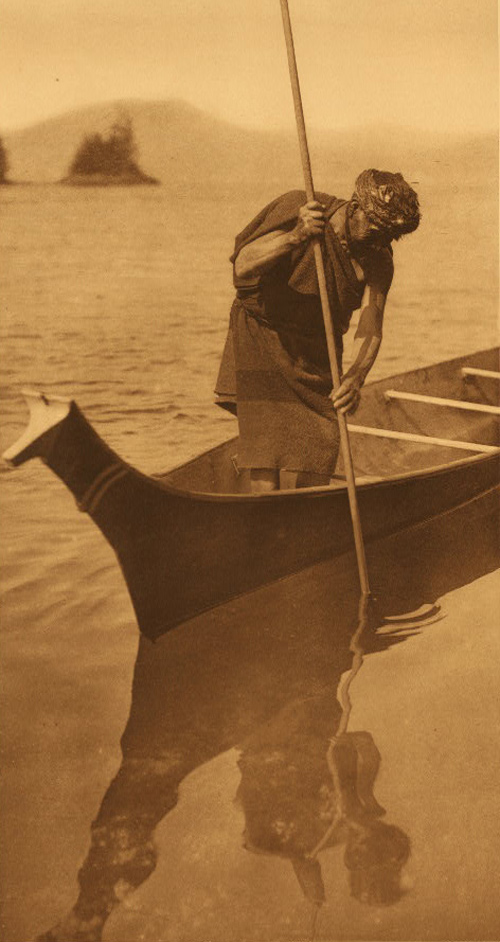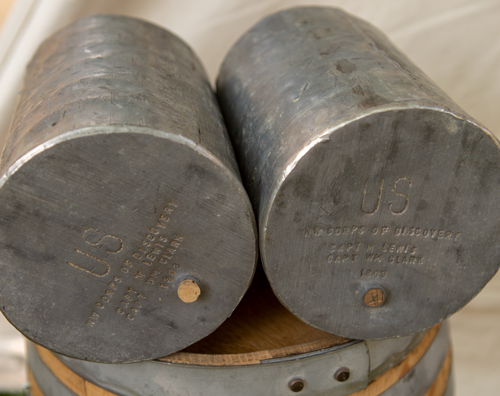Fort Clatsop, Astoria, OR While wintering at Fort Clatsop near present-day Astoria, Oregon, the lead canisters are unsealed, and the gunpowder they hold is safe and dry. The captains describe highly prized Chinookan canoes. At Leech Lake in Minnesota, Zebulon M. Pike reaches what he thinks is the source of the Mississippi River—his intended goal.
Fish Spearing – Clayoquot
Edward S. Curtis (1868–1952)
Northwestern University Library, Edward S. Curtis’s “The North American Indian,” 2003. http://curtis.library.northwestern.edu/site_curtis/.
Indian Canoes[1]Originally aired weekdays by Yellowstone Public Radio during the Bicentennial observance of 2003-2006. Narrated by Hal Hansen. Scripts by Whit Hansen and Ed Jacobson. Produced by Leni Holliman. © … Continue reading
Retrieving Elk
A number of the men [Joseph] went out to bring meat to the fort, and to take some to the saltworks.
—Joseph WhitehouseSergt. Gass with a party of five men again set out up the Netul river in surch of the Elk which had been killed some days since, and which could not be found in consequence of the snow.
—Meriwether Lewis
Highly Prized Chinookan Canoes
they prize their canoes very highly; we have been anxious to obtain some of them, for our journey up the river but have not been able to obtain one as yet from the natives in this neighbourhood.—
—Meriwether Lewis
About the fisherman and canoe in the photo, Curtis wrote:
The fisherman is taking flounders and other flatfish, which lie half-covered in the sand. At certain seasons, when the water is turbid by reason of the presence of excessive marine growth, objects on the bottom of a quiet bay can be discerned at a surprising depth. It is frequently assumed that the prows of North Coast canoes are carved in imitation of a dog’s head, but the natives deny any intentional resemblance. The notch in the top of the prow, dividing it into two sections suggestive of an animal’s ears, is simply a rest for the shaft of a spear or harpoon.”[2]Edward Curtis, The North American Indian (Cambridge: The University Press, 1916), vol. 11, plate no. 392.
Lead Canisters
“our only hope”
© 2017 by Kristopher K. Townsend. Permission to use granted under the Creative Commons Attribution-Share Alike 4.0 International license.
Inspecting the Ammunition
today we opened and examined all our ammunition, which had been secured in leaden canesters. we found [them] . . . perfectly as dry as when first put in the canesters, altho’ the whole of it from various accedents has been for hours under the water.
—Meriwether Lewisthese Cannisters Contain 4 pounds of powder each and 8 of Lead. had it not been for that happy expedient which Capt Lewis devised of securing the powder by means of the Lead, we Should have found great dificuelty in keeping dry powder untill this time—
—William Clark
Our Only Hope
we always take Care to put a purpotion of it in each canoe, to the end that Should one Canoe or more be lost we Should Still not be entirely bereft of ammunition, which is now our only hope for Subsistance and defences in the rout of 4,000 miles through a Country exclusively inhabited by Indians—many bands of which are Savage in every Sense of the word—.
—William Clark
Weather Diary
aspect of the weather at rise
Wind at rise
aspect of the weather at 4 OC1 P.M. Wind at 4 O’Clock P.M. fair N. E. fair N. E. the weather by no means as could as it was tho’ it freized last night
—Meriwether Lewis[3]To assist the reader, the editor of this web page has omitted the “Day of ye Month” column and spelled out some abbreviations.
Pike’s Turn Around Point
. . . arrived at Lake Le Sang Sue [Leech Lake], half past two OClock. I will not attempt to describe my feelings on the accomplishment of my voyage, this, being the main source of the Mississippi . . . . Crossed the Lake 12 Miles to the Establishment of the N.W. Company. Arrived there about ten OClock—found all the Gates locked; but on Knocking was admitted, and received (with my young man) with distinguished politeness and Hospitality, by Mr. Hugh M’Gillis. Had a good dish of Coffee, Biscuit, Butter, and Cheese for supper.
—Zebulon M. Pike[4]Donald Jackson, The Journals of Zebulon Montgomery Pike (Norman, Oklahoma: University of Oklahoma Press, 1966), 89.
Fort Clatsop is a High Potential Historic Site along the Lewis and Clark National Historic Trail managed by the U.S. National Park Service. The site is managed by the Lewis and Clark National and State Historic Parks.
Notes
| ↑1 | Originally aired weekdays by Yellowstone Public Radio during the Bicentennial observance of 2003-2006. Narrated by Hal Hansen. Scripts by Whit Hansen and Ed Jacobson. Produced by Leni Holliman. © 2003 by Yellowstone Public Radio. |
|---|---|
| ↑2 | Edward Curtis, The North American Indian (Cambridge: The University Press, 1916), vol. 11, plate no. 392. |
| ↑3 | To assist the reader, the editor of this web page has omitted the “Day of ye Month” column and spelled out some abbreviations. |
| ↑4 | Donald Jackson, The Journals of Zebulon Montgomery Pike (Norman, Oklahoma: University of Oklahoma Press, 1966), 89. |




